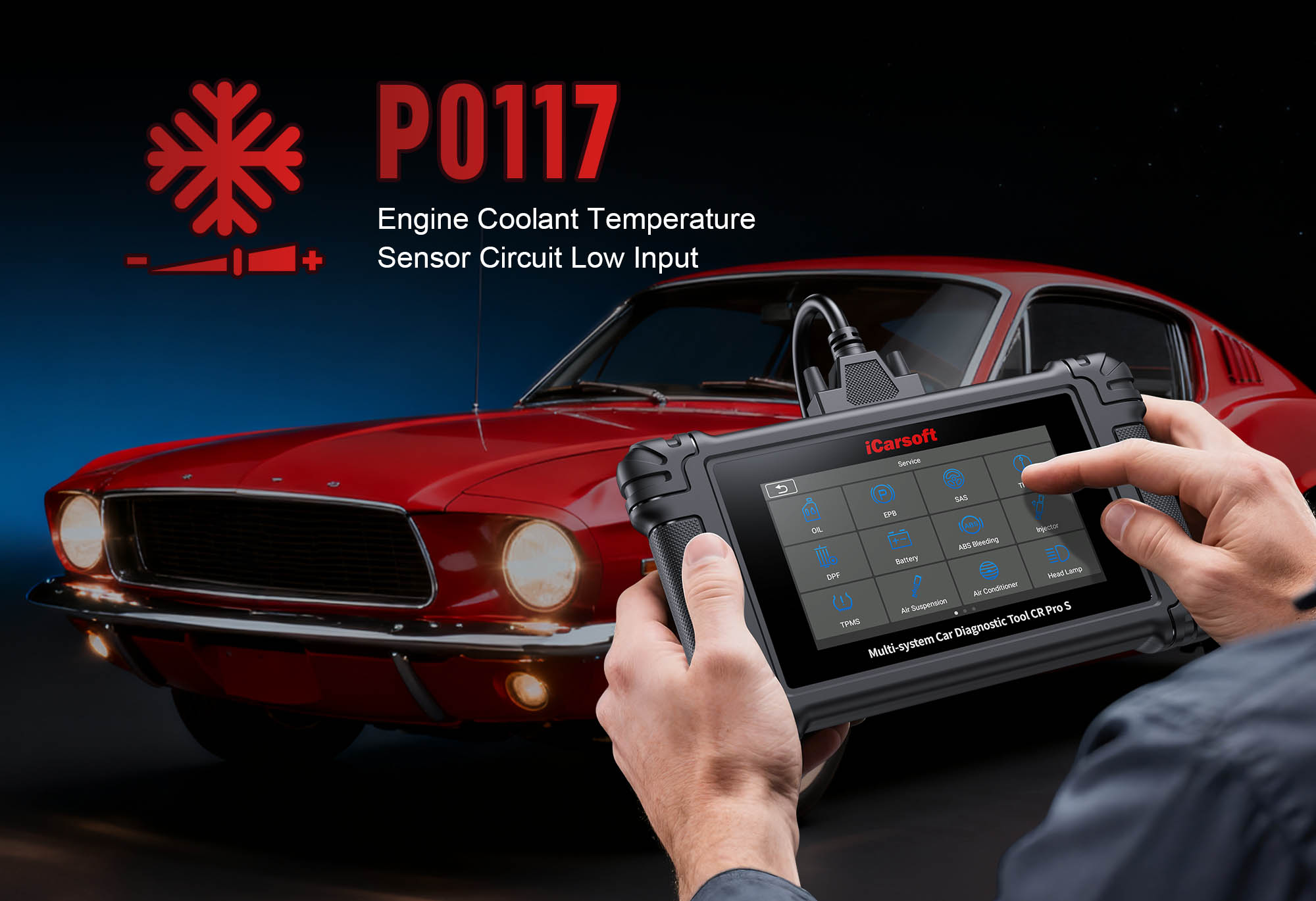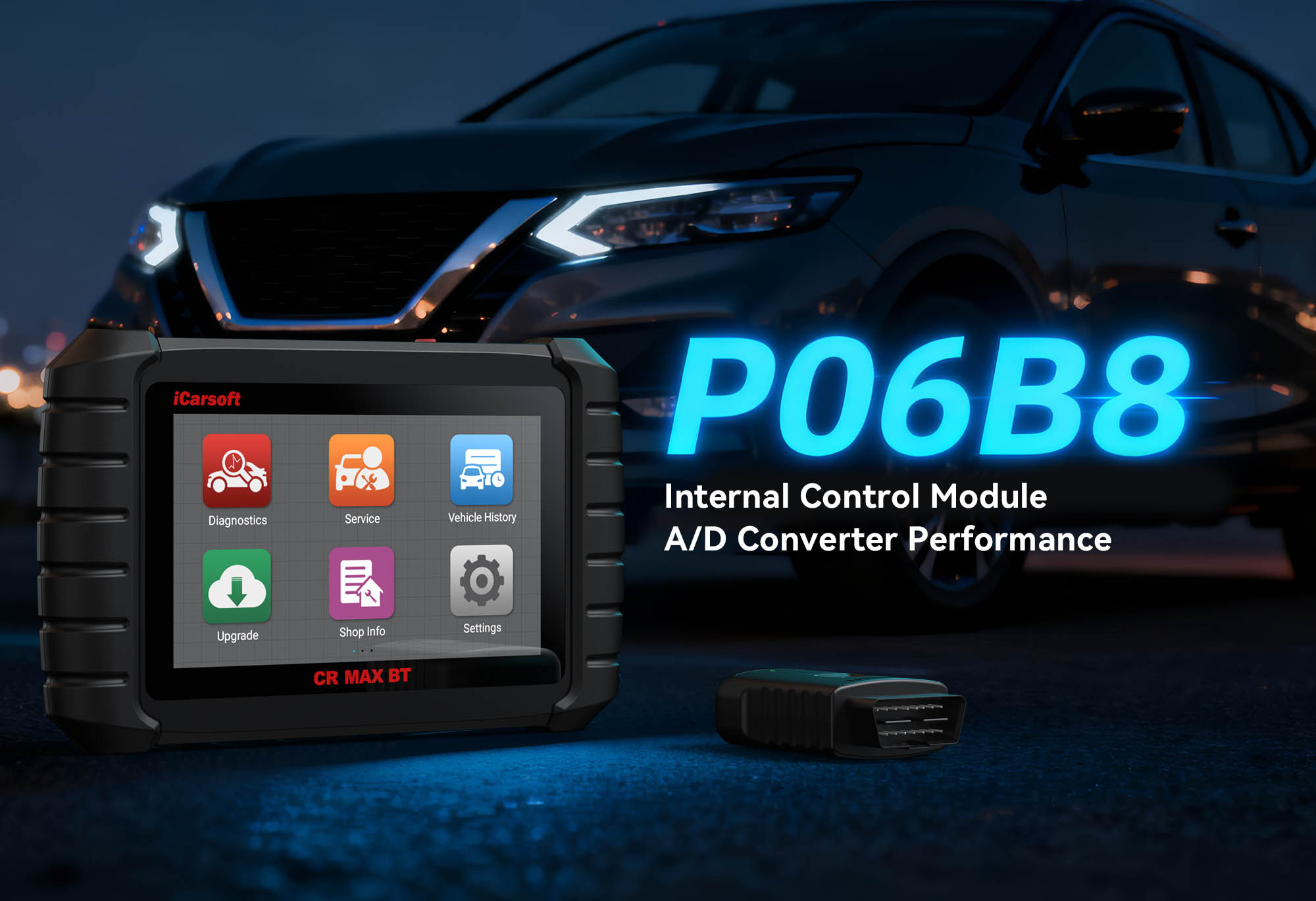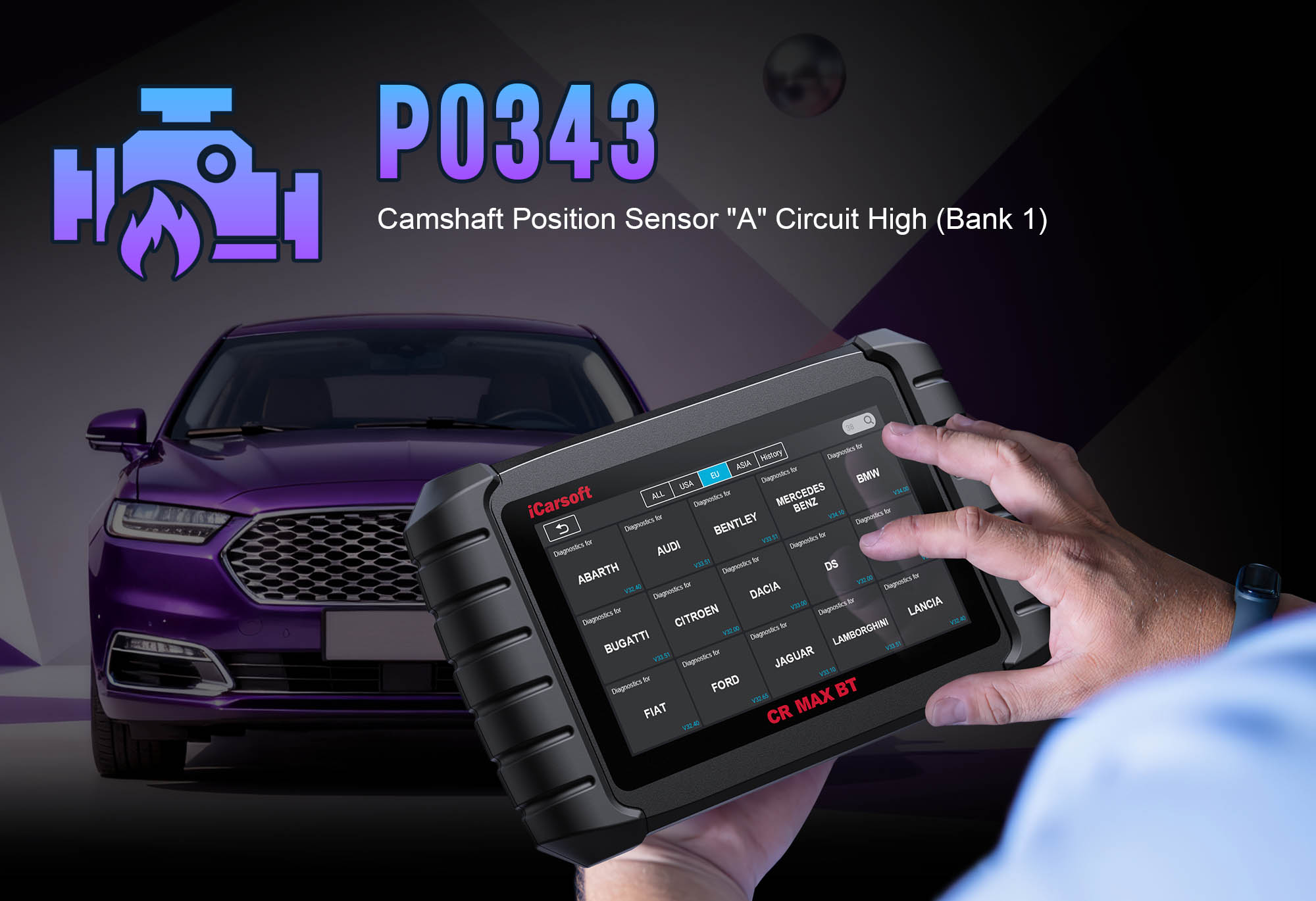P0117 Code: Diagnose & Clear Engine Coolant Temperature (ECT) Sensor Circuit Low Input with iCarsoft CR Pro S
If your check engine light turns on and you notice symptoms like hard starting, poor fuel efficiency, or erratic engine performance, a diagnostic scan will likely return P0117. This OBD-II code stands for "Engine Coolant Temperature (ECT) Sensor Circuit Low Input," meaning the Engine Control Module (ECM) receives an abnormally low voltage signal from the ECT sensor—usually indicating a false "extremely cold" reading (often below -40°F/-40°C) even when the engine is warm.
The ECT sensor monitors coolant temperature and sends voltage signals to the ECM, which uses this data to adjust fuel injection, ignition timing, and idle speed. A "low input" error (<0.5V, vs. normal 0.5–4.5V) stems from issues like a shorted sensor, damaged wiring, or failed ground. Left unaddressed, P0117 causes rough idling, increased emissions, and potential engine damage from incorrect fuel delivery.
Basic scanners only flag "ECT sensor fault" but can’t measure live voltage or isolate wiring issues. The iCarsoft CR Pro S, with ECT-specific diagnostics, real-time tracking, and continuity tests, solves this. Let’s walk through precise diagnosis and resolution.
Understanding P0117: Causes & Key Symptoms
A faulty ECT sensor circuit disrupts the ECM’s temperature readings, leading to symptoms tied to incorrect engine management—these clues help separate sensor issues from wiring or coolant problems.
Key Symptoms of P0117
-
Hard Starting/No Start: ECM enriches fuel too much (thinking the engine is cold), flooding the cylinders.
-
Poor Fuel Efficiency: Overly rich mixture increases fuel consumption by 15–25%.
-
Erratic Idle: Engine idles too high (>1,500 RPM) or fluctuates due to incorrect temperature data.
-
Engine Overheats: ECM delays radiator fan activation (thinking it’s cold), pushing temps above 220°F/104°C.
-
No Cabin Heat: Climate control relies on ECT data—false cold readings prevent heater operation.
-
Intermittent Issues: Symptoms come and go, triggered by temperature (wiring expansion) or vibration (loose connectors).
Common Causes of P0117
|
Cause
|
Description
|
|
Faulty ECT Sensor
|
Internal short-circuiting or degradation (sensors >80,000 miles) causes low voltage output.
|
|
Shorted Wiring/Connector
|
ECT circuit wire touches ground (chassis/engine block), dropping voltage to near 0V.
|
|
Corroded/Loose Connector
|
Rust or oxidation creates high resistance, leading to low voltage signals.
|
|
Damaged Ground Circuit
|
Broken/loose ground strap increases circuit resistance, causing low input.
|
|
ECM Malfunction
|
Faulty voltage regulator or internal circuit misinterprets normal signals (rare in 2015+ models).
|
|
Coolant Leaks
|
Low coolant exposes the sensor to air, causing false cold readings (even with a working sensor).
|
Why iCarsoft CR Pro S Excels at Diagnosing P0117
The CR Pro S outperforms basic tools with ECT sensor circuit-specific features, critical for isolating P0117’s root cause:
Live ECT Voltage Tracking
Monitors real-time voltage from the ECT sensor, flagging drops below 0.5V (P0117 threshold) instantly.
ECT Sensor Resistance Testing
Measures sensor resistance at cold/warm temps, verifying if it matches manufacturer specs.
Circuit Short/Continuity Tests
Identifies shorted wires or corroded connectors, ruling out electrical faults quickly.
Temperature Correlation Checks
Cross-references ECT with engine oil temperature (EOT) to spot false cold readings (e.g., ECT=-40°F vs. EOT=190°F).
Global Vehicle Coverage
Works with 500+ models (Ford, Toyota, Chevrolet, BMW, Mercedes-Benz) for ECT sensor location variations.
ECM Signal Verification
Tests if the ECM receives/processes ECT signals correctly, ruling out module faults.
Step-by-Step: Diagnose P0117 with iCarsoft CR Pro S
-
Check Coolant Level & Condition First
1. Ensure the engine is cold, remove the coolant reservoir cap. Fluid must be between "MIN" and "MAX"—add 50/50 coolant-water mix (manufacturer-recommended type) if low.
2. Inspect coolant quality:
- Sludge/particles = old coolant (replace every 50k–100k miles).
- Milky appearance = head gasket leak (consult pro to avoid engine damage).
- Cracked reservoir/hoses = leaks (repair before proceeding).
-
Connect the CR Pro S & Confirm the Code
1. Plug into the OBD-II port (use OBDI adaptors for older models: Mercedes 38Pin, BMW 20Pin).
2. Select your vehicle via Auto VIN Identify (instant specs) or manual entry.
3. Navigate to Engine > Fault Codes > Read Codes to confirm P0117. Tap Code Details for tips (e.g., "Toyota Camry: Target ECT Voltage = 0.5–4.5V, Check Connector Pins 2/3").
-
Locate the ECT Sensor
1. Go to Component Location > Engine > Cooling System > ECT Sensor.
2. Identify the sensor via the diagram:
- Small threaded sensor (2–3 pins) mounted on engine block, cylinder head, or coolant manifold (often near thermostat housing).
- Wiring harness (1–2 wires): One for signal, one for ground.
- Ground strap: Attached to engine block/chassis (critical for circuit function).
-
Analyze Live ECT Sensor Data
1. Start the engine, idle 5–10 minutes (warm slightly, no overheating).
2. Navigate to Engine > Live Data > Cooling System and monitor:
- ECT Voltage: Normal = 0.5–4.5V (drops with temp: ~4V cold, ~0.5V at 220°F). P0117 = <0.5V.
- ECT Temperature: Normal = 195–220°F warm. P0117 = <32°F (even warm).
- Engine Oil Temperature (EOT): Should align with ECT (±10–15°F). Mismatch = faulty ECT circuit.
- Radiator Fan: Turns on at ~220°F. No activation = ECM acts on false cold data.
-
Test the ECT Sensor Resistance
1. Cold Engine Test: - Engine off (cool 2+ hours). Disconnect ECT connector. Measure resistance between signal/ground pins. Normal = 2,000–10,000 ohms (model-specific). <100 ohms = shorted sensor (replace).
2. Warm Engine Test: - Start engine, warm to 195°F (use EOT as reference). Turn off, measure resistance again. Normal = 100–500 ohms. No drop = faulty sensor (replace).
-
Test the ECT Circuit for Shorts & Continuity
1. Short-to-Ground Test: - Sensor disconnected. Multimeter to "DC Voltage"—touch signal wire (connector) and ground. Normal = 5V (ECM reference). 0V = shorted wire (repair).
2. Ground Continuity: - Measure resistance between ECT ground pin and chassis. Normal = <1 ohm. >5 ohms = bad ground (clean/reattach strap).
3. Signal Wire Continuity: - Measure resistance between ECT signal pin and ECM pin (wiring diagram). Normal = <5 ohms. Higher = corrosion/frayed wire (clean/repair).
-
Perform ECM Signal Verification
1. Navigate to Special Functions > Engine > Cooling System > ECT Sensor Signal Test.
2. Tool sends simulated voltage (e.g., 2V = ~150°F) to ECM. Monitor response:
- ECM adjusts idle/fuel = ECM works.
- No response = ECM fault (consult professional).
-
Rule Out ECM Software Issues
1. ECM Firmware Update: - Go to System > Update Manager to install free updates (fixes misinterpreted signals).
2. ECT Calibration: - Select Special Functions > Engine > Cooling System > ECT Calibration to reset voltage-to-temperature mapping.
-
Repair & Clear P0117
1. Fix the root cause:
- Faulty Sensor: Replace with OEM unit (use Part Lookup for engine compatibility).
- Shorted Wiring: Repair/replace signal wire (avoid ground/hot engine parts).
- Corrosion/Ground: Clean connector (contact cleaner) or replace; tighten ground strap.
- Low Coolant: Refill and repair leaks (hoses, radiator cap).
- ECM Fault: Update firmware or consult specialist.
2. Clear the code: Navigate to Engine > Fault Codes > Clear Codes to delete P0117.
-
Validate the Repair
1. Recheck live data: ECT voltage 4V (cold) → 0.5V (warm); temp aligns with EOT.
2. Test drive 30–40 minutes (cold starts + highway): No hard starting, rough idle, or overheating.
3. Monitor fuel efficiency 1–2 weeks: Returns to normal (e.g., 25 MPG vs. 20 MPG before).
4. Post-drive scan: Use Cooling System Scan after 100 miles to confirm P0117 doesn’t return.
Preventing P0117 Recurrence
Use the iCarsoft CR Pro S to maintain ECT sensor and circuit health long-term:
-
Sensor Maintenance: Set Service Reminder to inspect ECT every 60,000 miles—replace every 100,000 miles (sensors degrade over time).
-
Coolant Care: Replace coolant every 50,000–100,000 miles; check levels monthly—low coolant triggers false P0117.
-
Circuit Checks: Include ECT continuity tests in annual electrical scans—catch frayed wires/corrosion early.
-
Ground Strap Inspection: Clean and tighten the ECT ground strap every 30,000 miles—poor grounding causes low voltage.
Conclusion
P0117’s ECT sensor low-input fault disrupts engine performance and wastes fuel—but the iCarsoft CR Pro S simplifies diagnosis with live voltage tracking, resistance tests, and circuit checks. Whether replacing a faulty sensor, fixing wiring, or refilling coolant, this tool ensures you fix the root cause (not just the symptom).
With the CR Pro S, you’ll restore accurate temperature readings, improve fuel efficiency, and keep your engine running smoothly—no more hard starts, overheating, or costly ECM repairs.
FAQs About P0117 Code
Q: Can I drive with P0117?
A: Short trips (to a repair shop) are possible, but prolonged driving risks engine overheating or flooding. Fix P0117 within 1 week to avoid damage.
Q: How much does it cost to fix P0117?
A: $50–$150 for an ECT sensor; $50–$200 for wiring/connector repairs; $400–$1,200 for ECM repairs. The CR Pro S saves by avoiding unnecessary ECM replacement.
Q: Will replacing the ECT sensor always fix P0117?
A: No—if P0117 is caused by shorted wiring or a bad ground, a new sensor won’t help. Use the CR Pro S to test the circuit first.
Q: What’s the difference between P0117 and P0118?
A: P0117 = "ECT Sensor Circuit Low Input" (voltage too low), while P0118 = "ECT Sensor Circuit High Input" (voltage too high). The CR Pro S distinguishes them via live voltage readings.





